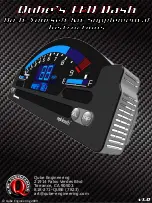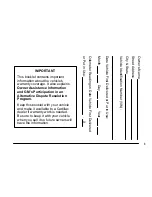
Parking the vehicle for more than four weeks
#
Method 1: connect the batteries to a trickle
charger via the jump-start connection.
#
Method 2: interrupt the power supply by acti-
vating standby mode (
/
page 143).
#
Method 3: disconnect all batteries. For this,
please contact a qualified specialist workshop.
Activating or deactivating standby mode
Requirements:
R
The power supply is switched on.
R
The vehicle is not switched on.
If standby mode is activated, energy loss will be
minimized during extended periods of non-opera-
tion.
Standby mode is characterized by the following:
R
The starter battery is preserved.
R
The maximum non-operational time appears in
the media display.
R
The connection to online services is interrup-
ted.
R
The ATA (anti-theft alarm system) is unavaila-
ble.
R
The interior protection and tow-away alarm
functions are not available.
Exceeding the vehicle's displayed non-operational
time may cause inconvenience; i.e. it cannot be
guaranteed that the starter battery will reliably
start the vehicle.
Charge the starter battery first in the following sit-
uations:
R
In order to extend the vehicle's non-opera-
tional time.
R
The
Battery Charge Insufficient for Standby
Mode
message appears in the media display.
%
Standby mode is automatically deactivated
when the vehicle is switched on.
On-board computer:
4
Settings
5
Vehicle
5
Standby Mode
#
To activate/deactivate: select
Yes
or
No
.
%
If the options are grayed out, the charge level
of the battery is not sufficient for standby
mode.
Driving and driving safety systems
Notes on driving systems and your responsibility
Your vehicle is equipped with driving systems that
assist you while driving, parking and maneuvering.
The driving systems are only aids. They are not a
substitute for you paying attention to your sur-
roundings and do not relieve you of your responsi-
bility pertaining to road traffic law. The driver is
always responsible for maintaining a safe distance
to the vehicle in front, for vehicle speed, for brak-
ing in good time and for staying in lane. Always pay
attention to the traffic and intervene if necessary.
Be aware of the limitations regarding the safe use
of these systems.
Driving systems can neither reduce the risk of
accident if you fail to adapt your driving style nor
override the laws of physics. They cannot always
take into account road, weather or traffic condi-
tions.
Certain driving and driving safety systems use sen-
sors
1
to monitor the area in front of, behind or
next to the vehicle (depending on the vehicle's
equipment).
Depending on the vehicle's equipment, the radar
sensors are integrated behind the bumpers and/or
behind the radiator grille. Keep these parts free of
dirt, ice and slush (
/
page 222). Do not cover the
sensors, for example, with bicycle racks, overhang-
ing loads or stickers. After a collision, have the
function of the radar sensors checked at a quali-
fied specialist workshop as the bumper or radiator
grille may have sustained damage that cannot be
seen by the naked eye.
Driving and parking 143
Содержание Sprinter
Страница 7: ......
Страница 12: ...NJ Brakes yellow 323 O ABS malfunction 323 På ESP deactivated 323 10 At a glance Instrument cluster ...
Страница 21: ...Example spare wheel 265 At a glance Emergencies and breakdowns 19 ...
Страница 213: ... A wheel arch may be subjected to a load of 330 lb 150 kg Transporting 211 ...
Страница 354: ......
















































